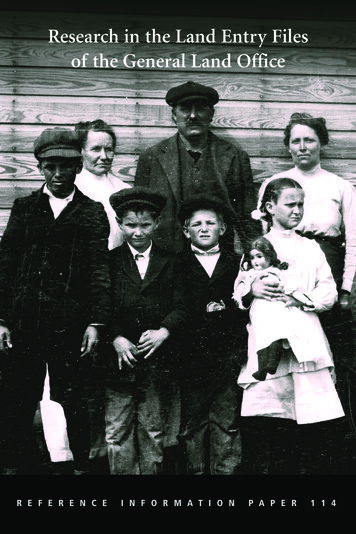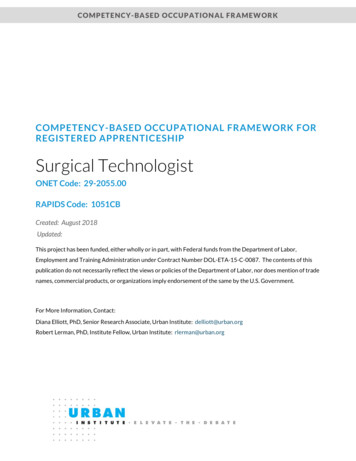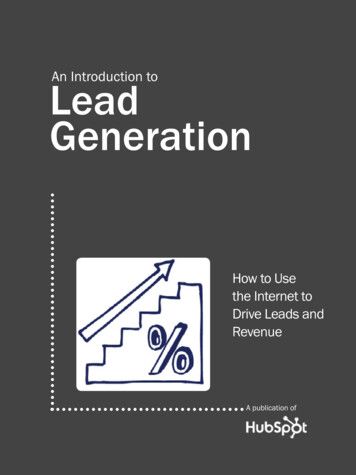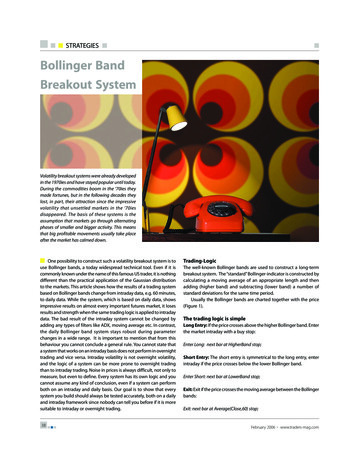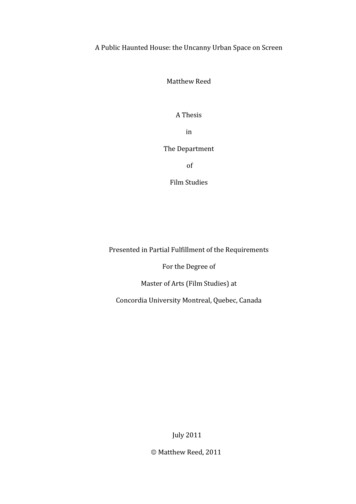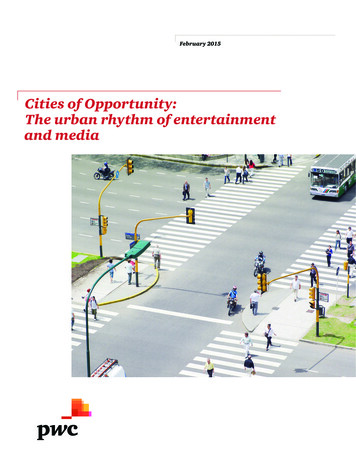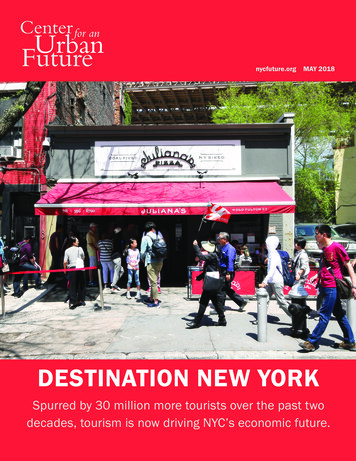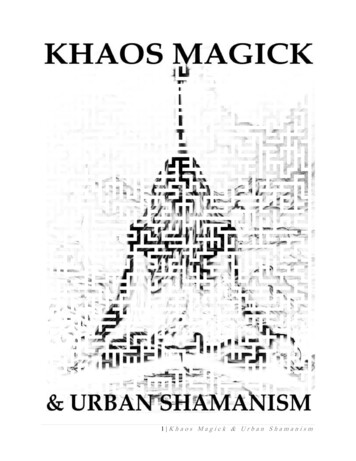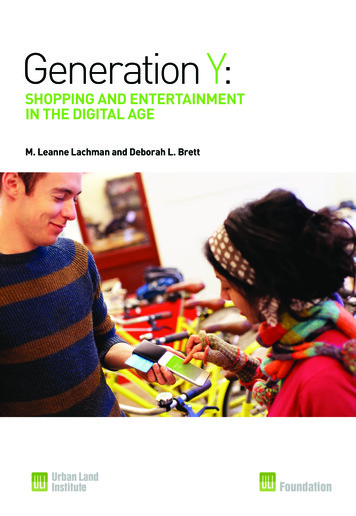
Transcription
Generation Y:Shopping and Entertainmentin the Digital AgeM. Leanne Lachman and Deborah L. Brett
Generation Y:Shopping and Entertainmentin the Digital AgeAbout theUrban Land InstituteThe mission of the Urban Land Institute is to provide leadership in the responsible use ofland and in creating and sustaining thriving communities worldwide. ULI is committed to Bringing together leaders from across the fields of real estate and land use policy toexchange best practices and serve community needs; Fostering collaboration within and beyond ULI’s membership through mentoring,dialogue, and problem solving; Exploring issues of urbanization, conservation, regeneration, land use, capitalformation, and sustainable development; Advancing land use policies and design practices that respect the uniqueness of boththe built and natural environments; Sharing knowledge through education, applied research, publishing, and electronicmedia; and Sustaining a diverse global network of local practice and advisory efforts that addresscurrent and future challenges.Established in 1936, the Institute today has nearly 30,000 members worldwide,representing the entire spectrum of the land use and development disciplines. ULIrelies heavily on the experience of its members. It is through member involvementand information resources that ULI has been able to set standards of excellence indevelopment practice. The Institute has long been recognized as one of the world’s mostrespected and widely quoted sources of objective information on urban planning, growth,and development.Recommended bibliographic listing:Lachman, M. Leanne, and Deborah L. Brett. Generation Y: Shopping and Entertainment in the Digital Age. Washington, D.C.:Urban Land Institute, 2013.ISBN: 978-0-87420-279-3Copyright 2013 by the Urban Land Institute1025 Thomas Jefferson Street, NWSuite 500 WestWashington, DC 20007-5201Printed in the United States of America. All rights reserved. No part of this book may be reproduced in any form or byany means, electronic or mechanical, including photocopying and recording, or by any information storage and retrievalsystem, without written permission of the publisher.i
About theULI FoundationBoard of DirectorsJuly 1, 2012–June 30, 2013James J. CurtisULI Foundation ChairmanPeter RummellULI ChairmanRobert LieberULI Board of Directors MemberBret WilkersonULI Policy and Practice ChairmanRandy RoweULI Foundation TreasurerJohn HealySecretaryThe ULI Foundation is the philanthropic partner of the Urban LandInstitute, providing an assured source of funding for ULI’s core research,education, and public service activities. Through its various givingprograms, the Foundation helps strengthen ULI’s ability to provideleadership in the responsible use of land to enhance the total environment.The Foundation particularly wishes to thank John Bucksbaum for hissupport of this research effort. John Bucksbaum, CEO of BucksbaumRetail Properties, has been a longtime supporter of the ULI Foundation.John’s generous endowment gift of 1 million, given on behalf of theBucksbaum family, created the Bucksbaum Family Chair for Retail in 2001.John has served as an active member of the board of directors of the ULIFoundation, served as a trustee of ULI, and held numerous council andcommittee leadership positions at ULI over the years.The ULI Foundation would like to recognize the following individuals fortheir generous philanthropy in supporting the mission of the Urban LandInstitute to provide leadership in the responsible use of land.At-Large MembersRosalind GorinJohn BucksbaumJames ToddBruce EtkinEx-Officio MembersGeoffrey Stack, Annual Fund ChairRoger Orf, U.K. Charitable Trust ChairJames D. Klingbeil, ULI FoundationChair EmeritusPatrick Phillips, ULI CEOBenefactors of the ULI FoundationJohn BucksbaumMatthew BucksbaumJoseph CanizaroGerald HinesJames KlingbeilDaniel RoseJ. Ronald TerwilligerSustainers of the ULI FoundationStephen ChamberlinSusan ChamberlinJames CurtisRichard M. RosanPresident, ULIFDevelopers of the ULI FoundationDouglas AbbeyCharles CobbHarry FramptonLizanne GalbreathGreenlaw “Fritz” GrupeJohn HagestadMichael HorstCharles LeitnerBowen “Buzz” McCoyRobert McLeodMasud MehranRonald NahasPeter RummellJames ToddGreg VogeliiBuilders of the ULI FoundationToni AlexanderMahlon ApgarJoseph AzrackPreston ButcherJames DeFranciaRichard GollisRosalind GorinJames HarrisGadi KaufmanMark KehkeEric LarsonAnthony MansourFrancis NajafiJerome RappaportMichael SchuelerGeoffrey StackThomas ToomeyFrank Transue
Generation Y:Shopping and Entertainmentin the Digital AgeAbout the AuthorsM. Leanne Lachman is president of Lachman Associates, a real estateconsulting firm serving private and institutional investors. She is also anexecutive-in-residence at Columbia University’s Graduate Business Schooland serves on the boards of Liberty Property Trust and Lincoln NationalCorporation.After an early career in market analysis with Real Estate ResearchCorporation, where she was president and chief executive officer for eightyears and initiated the Emerging Trends in Real Estate publication, Lachmanmoved into portfolio management for pension funds. She spent 13 years as apartner with Schroder Real Estate Associates, which was sold to Lend LeaseReal Estate Investments, where she was head of real estate strategies.Lachman is widely published and is a frequent speaker. She is a ULI trusteeand governor; is listed in Who’s Who in America, Who’s Who in Finance andIndustry, and The World Who’s Who of Women; and received the JamesGraaskamp Award for pragmatic real estate research in 1997 from thePension Real Estate Association. She was awarded a BA from the Universityof Southern California and an MA from Claremont Graduate University.Project StaffKathleen CareyChief Content OfficerMaureen McAveyULI/Bucksbaum FamilyChair for RetailJames A. MulliganManaging EditorDavid James RoseManuscript EditorBetsy VanBuskirkCreative DirectorJohn Hall Design GroupGraphic DesignCraig ChapmanSenior Director, PublishingOperationsDeborah L. Brett is a real estate and planning consultant for a wide rangeof public and private organizations, providing project-related marketanalyses. Areas of specialization include development planning, commercialrevitalization, market-rate and affordable housing, mixed-use projects, andtransit-oriented development.Brett formed Deborah L. Brett & Associates, based in Plainsboro, NewJersey, in 1993. She previously served as senior vice president and directorof consulting services at Real Estate Research Corporation in Chicago. Inher 18-year career there, she directed land use policy studies for manygovernment agencies and prepared development strategies and analyses forprivate clients.Brett holds a master’s degree in urban and regional planning from theUniversity of Illinois at Urbana-Champaign. She is a longtime member ofULI and a frequent contributor to its publications, including Real EstateMarket Analysis: Methods and Case Studies, used by real estate and planningprograms at many universities. Brett is also a member of the AmericanInstitute of Certified Planners and Lambda Alpha, the real estate and landeconomics honorary society.Dr. Lawrence Becker provided assistance in survey design, sampling, andstatistical analysis. He holds a PhD in social psychology from the Universityof California at Davis and has extensive experience in market and advertisingresearch.iii
LetterDear Reader:Demographics continue to fascinate. As the U.S. economic recovery settles in and strugglesfor firm footing, market participants reflect on what various age cohorts will need and want. Ofparticular interest is the Generation Y/Millennial population, now 18 to 35 years of age and thelargest age cohort in American history. This group has been slow to marry and slow to becomefinancially independent and espouses less interest in “worldly” goods. Is this a function ofthe aftermath of the Great Recession, a fundamental change in values, or their difficultiesin finding well-paying jobs? About 80 million in size, this group constitutes more than 25percent of the U.S. population. What the Millennials do and how they consume will affect theeconomy—and real estate—in material ways.The Urban Land Institute has taken a special interest in Gen Y, given its size and the marketuncertainty about how members of this age cohort will move into the full economy. In 2010, theInstitute commissioned a study led by M. Leanne Lachman and Deborah L. Brett, Generation Y:America’s New Housing Wave. A statistically accurate survey aligned to the 2010 census, thestudy produced results indicating that while Gen Y may be slow to jump into homeownershipen masse, a full 35 percent of the members of this generation already own homes and a robust82 percent expect to own homes by 2015. While this may prove optimistic in light of today’s tightlending requirements and hefty downpayment needs, Gen Y looks to both follow and changesome housing assumptions relative to urban and suburban residential patterns.The success of the Gen Y housing study suggested that ULI explore Gen Y and retail patterns.Retail is undergoing both good times and bad. While “creative destruction” is shaking up theindustry and causing closures and repositioning, retail has remained surprisingly strong overthe past five years. The retail real estate mix continues to evolve as seen in power centers,traditional malls, and lifestyle centers. Internet sales, instant access to product reviews,fashion blogs, and continuous sales information are challenging all retailers and offeringshoppers more information than ever before. What to make of it all?This study, Generation Y: Shopping and Entertainment in the Digital Age, is based on a representative sample of American Gen Y consumers. Of greatest interest to the real estate communityis Millennials’ enthusiasm for shopping in all its forms. Shopping is seen as entertainment andis done alone as well as with family and friends. It is clearly an extension of the social network.Gen Y seeks out high stimulation, requiring retail venues to stay on top of changing trendsand regularly upgrade their facilities and offerings. The competition is fierce and the best aregetting better. A dizzying array of tools now allows retailers to stay in touch with consumersand track preferences.We hope this publication will again spur lively dialogue and interest across all ULI platformsand networks. Retail affects the liveliness of place, and contributes to the urbanization ofsuburban town centers as well as to the revitalization of downtown cores. Often critical to thesuccess of mixed-use developments, retail is the front face of many of our projects and core tocommunity building.I would like to particularly thank John Bucksbaum and the Bucksbaum family for theirgenerous support of this study.Patrick L. PhillipsChief Executive OfficerUrban Land Instituteiv
Generation Y:Shopping and Entertainmentin the Digital AgeContents1 Key Findings6 Where Gen Y Lives7 Gen Y’s Finances9 Shopping Center Patronage12 Store Patronage16 Grocery Shopping18 Online Shopping22 Dining and Entertainment24 Free-Time Activities26 Rent versus Buy28 Notes29 Appendix: Survey Methodologyv
Generation Y:Shopping and Entertainmentin the Digital AgeGeneration Y:Shopping and Entertainmentin the Digital AgeGreat news for retail real estate owners: Generation Y thoroughly enjoys shopping andfrequently visits most types of centers. However, the challenging corollary is that 18- to35-year-olds are bored easily, so they’re on the lookout for new excitement—online, inbrick-and-mortar settings, and in restaurants. Sensory aspects of retail facilities need toevolve constantly in order to retain young shoppers’ patronage.In January 2013, ULI and Lachman Associates conducted a nationally representative onlinesurvey of 1,251 Gen-Yers to gauge their retail, dining, and entertainment preferences.1 Thesurvey design reflects the results of a focus group conducted at Columbia University’sGraduate School of Business in Manhattan, as well as a search of the literature on GenY’s shopping habits and free-time activities. The two-page spread (figure 2) that beginson page 2 illustrates the survey respondents’ demographics, and detailed findings arepresented in the body of this monograph. This section addresses real estate implicationsof the survey results.Key FindingsFigure 1 breaks down Gen Y’s viewpoint: 37 percent love shopping, another 48 percentenjoy it, and 12 percent view it as a chore but can cope with it; only 4 percent hate to shop.Half the men and 70 percent of the women consider shopping a form of entertainment andsomething to share with friends and family. Importantly, that is an aspect of shopping thatFigure 1:Attitudes about ShoppingLove to shopShop whennecessary, andI enjoy itShopping is anecessary chore;I can deal with it48%12%Hate shoppingTotal ck55%34%8%3%Other132%50%17%1%Sample size: 1,251.Source: ULI/Lachman Associates Survey, January 2013.Note: Totals may not add up to 100 percent because of rounding.1. Other includes Asians, Native Americans, Pacific Islanders, and people who identify themselves as biracialor multiracial.1
Figure 2: Profile of Surveyed Gen-YersPercentageof totalsampleGenderPercentageof totalsampleMarital statusMale49%SingleFemale51%Divorced or 8%Race64%Living with children under age 18Yes37%No63%Have a Pet ownerHispanic originYes20%No80%Percentageof totalsampleEducational attainmentNo high school diploma9%High school graduate19%Some college, trade school, apprenticeship37%Bachelor's degree22%Postgraduate study/advanced degree13%Parental contribution to living expensesNone65%Under 25%9%25%–49%10%50%–100%16%Sample size: 1,251, except Gen-Yers’ Household Income—sample size: 1,1
01.07.2012 · The Urban Land Institute has taken a special interest in Gen Y, given its size and the market uncertainty about how members of this age cohort will move into the full economy. In 2010, the Institute commissioned a study led by M. Leanne Lachman and Deborah L. Brett, Generation Y: America’s New Housing Wave. A statistically accurate survey aligned to the 2010 census, the study produced .



